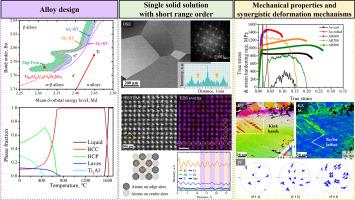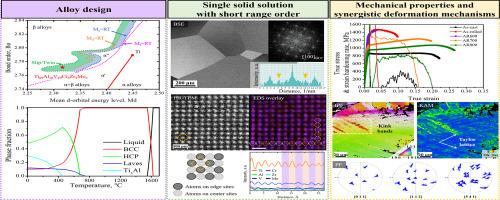轻量化Ti-Al-V-Cr-Zr-Mo中熵合金的成分设计及协同变形机理
IF 9.3
1区 材料科学
Q1 MATERIALS SCIENCE, MULTIDISCIPLINARY
引用次数: 0
摘要
基于热力学计算和电子结构导向Bo-Md方法,制备了一种成分为Ti68Al10V10Cr6Zr4Mo2的非等原子ti基中熵合金。该合金在铸态时的屈服强度为~ 826.3 MPa,经过热处理后的屈服强度增加到~ 1370 MPa,同时保持了良好的延展性。高合金含量不仅会引起显著的固溶强化,而且会导致短程有序(SRO)的形成。原子分辨率图像和相关化学作图显示b2型SRO的存在,在小原子(Cr、V和Mo)和大原子(Ti、Al和Zr)之间存在优先元素对。这种SRO在早期变形过程中促进平面位错滑移,使泰勒晶格形成,增强应变硬化和延迟颈缩。塑性变形后期出现扭结带,进一步提高了合金的延展性。因此,这项工作不仅仅是应用中熵合金概念,而是利用高合金激活的多层次变形机制来实现优越的机械性能。这项工作为钛基MEAs中sro驱动的变形机制提供了新的见解,并为设计下一代轻质结构材料提供了可行的途径。本文章由计算机程序翻译,如有差异,请以英文原文为准。


Compositional design and synergistic deformation mechanisms of a lightweight Ti-Al-V-Cr-Zr-Mo medium-entropy alloy
A new non-equiatomic Ti-based medium-entropy alloy with the composition of Ti68Al10V10Cr6Zr4Mo2 was developed based on thermodynamic calculations and the electronic structure-guided Bo−Md approach. This alloy exhibits a yield strength of ∼826.3 MPa in the as-cast state, which increases to ∼1370 MPa after thermomechanical processing, while retaining substantial ductility. The high alloying content not only induces significant solid solution strengthening, but also leads to the formation of short-range order (SRO). The atomic resolution image and correlated chemical mapping revealed the presence of B2-type SRO with preferential elemental pairs between small atoms (Cr, V, and Mo) and large atoms (Ti, Al, and Zr). This SRO promotes planar dislocation slip during early deformation, enabling Taylor lattice formation that enhances strain hardening and delays necking. In the later stages of plastic deformation, kink bands emerge and further improve the alloy’s ductility. Thus, rather than merely applying the medium-entropy alloy concept, this work leverages multi-level deformation mechanisms activated by high alloying to achieve superior mechanical properties. This work provides new insights into SRO-driven deformation mechanisms in Ti-based MEAs and offers a viable pathway for designing next-generation lightweight structural materials.
求助全文
通过发布文献求助,成功后即可免费获取论文全文。
去求助
来源期刊

Acta Materialia
工程技术-材料科学:综合
CiteScore
16.10
自引率
8.50%
发文量
801
审稿时长
53 days
期刊介绍:
Acta Materialia serves as a platform for publishing full-length, original papers and commissioned overviews that contribute to a profound understanding of the correlation between the processing, structure, and properties of inorganic materials. The journal seeks papers with high impact potential or those that significantly propel the field forward. The scope includes the atomic and molecular arrangements, chemical and electronic structures, and microstructure of materials, focusing on their mechanical or functional behavior across all length scales, including nanostructures.
 求助内容:
求助内容: 应助结果提醒方式:
应助结果提醒方式:


